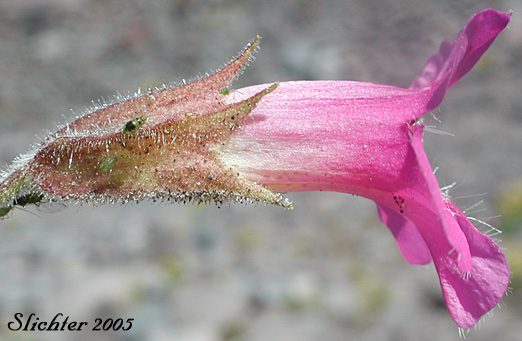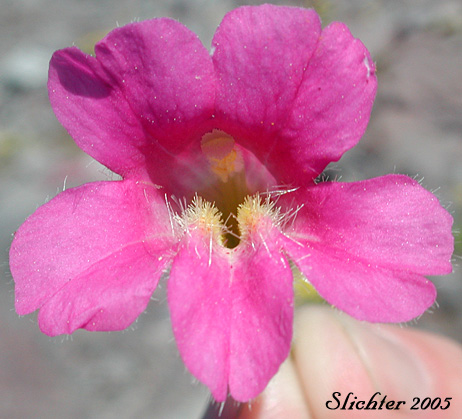 The
photo above shows a close-up side-view of the flower of Lewis' monkeyflower
as seen along the Highline Trail #114 at the western-most branch of the Muddy
Fork on the northern slopes of Mt. Adams.......July 23, 2005. Note
the glands on the calyx.
The
photo above shows a close-up side-view of the flower of Lewis' monkeyflower
as seen along the Highline Trail #114 at the western-most branch of the Muddy
Fork on the northern slopes of Mt. Adams.......July 23, 2005. Note
the glands on the calyx.
Characteristics:
Lewis' monkey flower is an attractive perennial with clumped, erect stems from 30-80 cm high. The stems arise from stout, branched rhizomes. The herbage is sticky-hairy. The opposite leaves are lance-to egg-shaped with pointed tips and have palmate venation of 3-7 strong veins. The leaves range from 3-7 cm long and the margins are irregularly toothed. The lower leaves are small and soon wither.
The inflorescence is an open, few to several flowered raceme. The calyx is 18-28 mm long with glandular-pubescent hairs. The calyx lobes are roughly equal in size and length, measuring 3-7 mm long. The lobes are narrowly triangular in shape, often with recurved tips. The showy flowers are pinkish-purple with yellowish throats. They are tubular with 2 lips, with the 5 lobes of the lips about equal in size. The corolla ranges from 3-5 cm long (of which the tube is 22-37 mm) and from 2-4 cm wide.
The flowers are snap dragon-like. They are pollinated by bees which must enter the mouth of the flower and crawl into the tubular corolla. In doing so, their backs rub against the pollen bearing anthers which in turn dust them with yellowish pollen grains. The bee then carries the pollen to the next flower. As the bee enters the mouth of the second flower, its back brushes against the long, slender stigma, depositing the a load of pollen.
Lewis' monkey flower is found in and along streams and in other wet places at medium to higher elevations in the mountains.
Lewis' monkey flower is found in mountainous areas from British Columbia south to California and east to Alberta, and south through the Rocky Mts. of Montana, Wyoming, and Utah.
In the Columbia River Gorge, it is occasionally seen along the lower Deschutes River, including just upstream from its mouth. Out of its montane habitat, it probably arrived in these locations as floating seeds or sections of plants that broke off and washed downstream.
